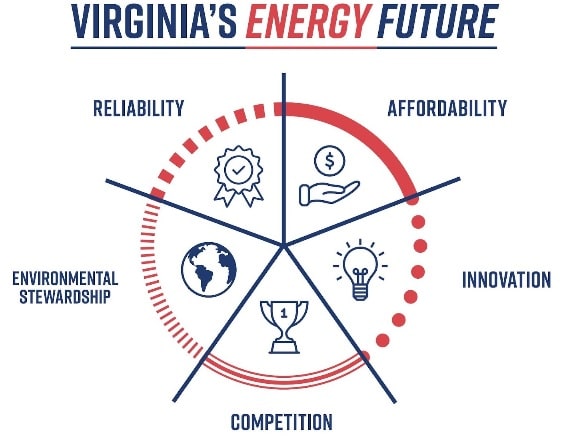Virginia’s 2022 Energy Plan Supports Diverse Energy Mix

Virginia Governor Glenn Youngkin on Oct. 3 released the state’s 2022 Energy Plan which provides an analytical assessment of the current energy economy and outlines an approach for policy decisions. To meet the growing demand of residents and businesses, the plan calls for an “all of the above” approach that taps nuclear, natural gas, renewables, and new energy sources. The plan is based on five main guiding principles: reliability, affordability, innovation, competition and environmental stewardship.
Among the key recommendations, the plan calls for the deployment of the nation’s first small, modular reactor in Southwest Virginia within the next 10 years and the creation of a nuclear energy innovation hub. Nuclear power currently makes up 14 percent of the state’s energy mix, and provides 95 percent of its carbon-free power. The majority of the state’s energy capacity consists of baseload generation sources, such as natural gas and nuclear, which represent 50 percent and 14 percent of capacity, respectively. As of December 2021, Virginia had 661 megawatts of installed wind and solar capacity which is 3 percent of the total power capacity.
The plan also includes proactive measures for protection of natural resources including farmland, freshwater rivers and streams. According to the Energy Information Administration, Virginia reduced carbon dioxide emissions by 20 percent, sulfur oxides emissions by 91percent and nitrogen oxides emissions by 58 percent from 2010 to 2020 due to transition from coal to lower emission natural gas generations.
The plan underscores the shift from coal to natural gas has enabled the state to achieve significant emissions reductions even before joining RGGI in 2020, and therefore “participation in RGGI is a bad deal for Virginia.” Before joining RGGI, the state had organically reduced its carbon emissions rate by more than 43 percent. Because utilities can directly pass RGGI costs to consumers through a rate adjustment clause, any incentive for utilities to reduce emissions or costs is eliminated. “In Virginia, RGGI is simply a tax on ratepayers that does not alter the behavior of electrical utilities and subjects Virginians to the emissions performance of other states,” according to the report.
The energy plan suggests periodic reassessments that utilize techno-economical analysis to decide Virginia’s path forward. It also recommends strategic investments in evolving areas which includes carbon capture and offshore wind energy.
EnerKnol Pulses like this one are powered by the EnerKnol Platform—the first comprehensive database for real-time energy policy tracking. Sign up for a free trial below for access to key regulatory data and deep industry insights across the energy spectrum.
ACCESS FREE TRIAL